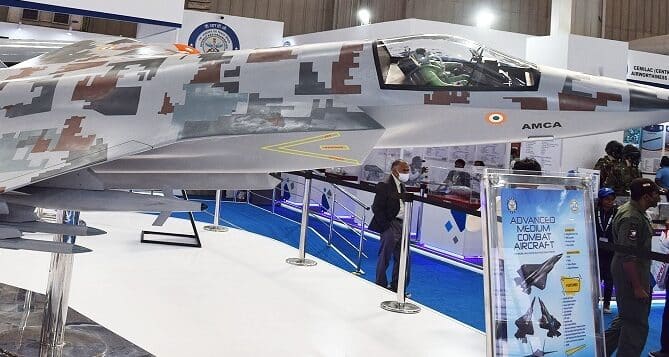Aerospace
By 2028, India’s AMCA fifth-generation fighter jet prototype may fly.
India has been competing with numerous other countries in the development of a fifth-generation fighter jet.

According to representatives of the Aeronautical Development Agency (ADA), a part of India’s Defence Research and Development Organization, the plan then needs approval from the Cabinet Committee on Security (CCS) (DRDO). The CCS will soon approve the AMCA, according to media reports.
“Once the project approval is secured, the first prototype may be put out in three years, and the maiden flight can be in one to one and a half years after that,” AMCA Project Director AK Ghosh said at the just concluded Defence Expo, where a model of the AMCA was shown last week. This timeline indicates that the AMCA will take to the skies for the first time in 2028.
Along with choices about the defense budget, the CCS, which reports to the Cabinet Secretariat, is in charge of making significant appointments and decisions regarding matters of national security.
The CDR attempts to finish the analysis, simulations, drawings, and testing in order to finalize designs.
Most of the indigenous products for the Tejas Mark 2 are also being developed by HAL and DRDO, such as the Pilot ejection seat and the Mid Air Refueling knob, which will aid the AMCA project greatly if they are successful.
The Tejas Mark 2 is slated to fly for the first time early next year, likely concurrently with its involvement in the AMCA, which will be India’s most eagerly anticipated project. Many other nations, including the USA, the UK, and Japan, have expressed a desire to participate in the development. Additionally, engine manufacturers Safran, GE, and Rolls Royce are also interested in collaborating on AMCA projects.
Rolls Royce in talks with DRDO to rev up AMCA engines(Opens in a new browser tab)
The AMCA would be a stealth fighter jet weighing 25 tonnes that had twin engines and an internal weapons bay. A Driverless Supersonic Intake, which was created for the first time in India, will also be included. It is useful to compress the air that prevents Mach speed breach while directing boundary layer airflow away from the aircraft’s engine, doing so without the need for a splitter plate.
The aircraft’s radar cross-section can be reduced by the internal weapons bay, which has a payload capacity of 1500 kg, an exterior payload of 5,500 kg, and an internal fuel capacity of 6,500 kg. This will increase the stealth of the aircraft.

Aerospace
When Ratan Tata was denied entry to the airfield at the Aero India show, he waited

During our visit to Aero India 2019, we had the unexpected opportunity to see Ratan Tata at the event, which was a thrilling moment for us. However, there was a surprising hiccup when the security staff didn’t allow him to enter due to a lack of a security pass.
Despite this, he remained calm and patiently waited for about 20 minutes until a member of the Tata team brought him the required pass, after which he calmly proceeded inside. It was a humbling sight, showcasing his composed demeanor even in such situations.
Ratan Tata ji is not only a renowned industrialist but also a trained pilot, holding a pilot’s license. In 2007, he became the first Indian civilian to fly the F-16 Falcon during the Aero India show in Bangalore—a proud moment for the nation.
His passion for aviation extended beyond flying, as he played a key role in shaping India’s aerospace industry. Under his leadership, Tata ventured into manufacturing and maintaining aerospace components while upholding its legacy of quality. Notably, Tata’s collaboration with Airbus to develop and manufacture the C295 aircraft is a testament to its growing influence in the sector.
-

 Aviation2 months ago
Aviation2 months agoMicrosoft Flight Simulator Raises $3 Million to Bring Back the An-225 Mriya
-

 Airlines2 months ago
Airlines2 months agoQantas Engineers Stage Walkout Over Cost of Living Concerns
-

 Airlines2 months ago
Airlines2 months agoQatar Citizens Can Travel to the United States Without a Visa
-

 Aviation2 months ago
Aviation2 months agoQatar Airways bans these new Electronic Devices on plane
-

 Airlines2 months ago
Airlines2 months agoJapan Airlines Rolls Out Free Domestic Flights to International Passengers
-

 Defence2 months ago
Defence2 months agoWhich Country Has the Largest Fleet of Fighter Aircraft?
-

 Airport2 months ago
Airport2 months agoWestern Sydney Airport Welcomes Its First Plane After 6 Years of construction
-

 Aviation2 months ago
Aviation2 months agoDid you know ? Once Boeing 747 carried 1088 passenger in 1991








